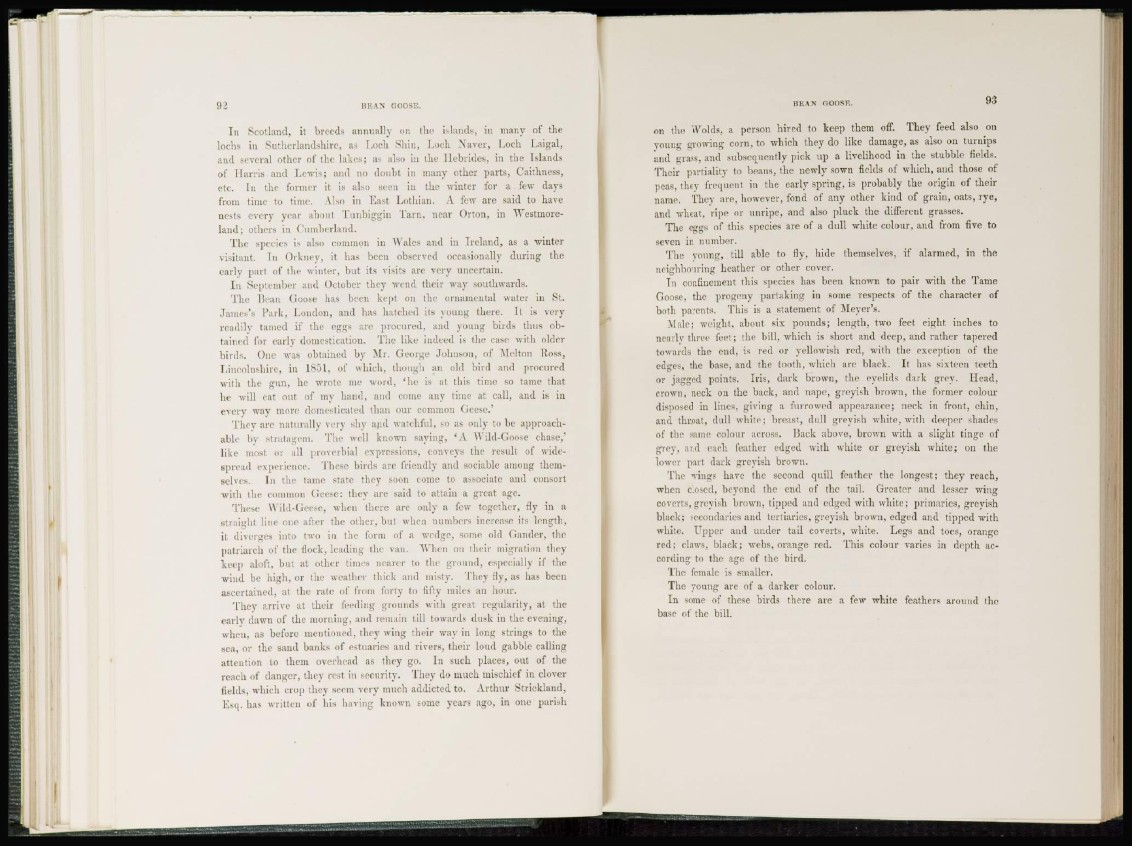
92 B E A N GOOSE.
In Scotland, it breeds annually on the islands, in many of the
lochs in Sutherlandshirc, as Loch Shin, Loch Xaver, Loch Laigal,
and several other of the lakes; as also in the Hebrides, in the Islands
of Harris and Lewis; and no doubl In many other parts, Caithness,
etc. In the former it is also seen in the winter for a few days
from time to time. Also in East Lothian. A few are said to have
nests every year about Tunbiggin Tarn, near Orton, in Westmoreland;
others in Cumberland.
The species is also common in Wales and in Ireland, as a winter
visitant. I a ()rkney, it has been observed occasionally during the
early part of the winter, but its visits are very uncertain.
I n September and October they wend their way southwards.
The I lean (loose has been kept on the ornamental water in St.
James's Park', London, and has hatched its young there. It is very
readily tamed if the eggs are procured, and young birds thus obtained
for early domestication. The like indeed is the case with older
birds. One was obtained by Mr. George Johnson, of Melton Ross,
Ilincolnshire, in 1851, of which, though an old bird and procured
wit li the gun, he wrote me word, 'he is at this time so tame that
he will eat out of my hand, and come any time at call, and is in
everv way more domesticated than our common Geese.*
They arc naturally very shy and watchful, so as only to be approachable
by stratagem. The well known saying, ' A \\ ild-Goose chase/
like most or all proverbial expressions, conveys the result of widespread
experience. These birds are friendly and sociable among themselves.
In the tame state they soon come to associate and consort
with the common Geese: they are said to attain a great age.
These Wild-Geese, when there are only a few together, fly in a
straight line one after the other, but when numbers increase its length,
it diverges into two in the form of a wedge, some old Gander, the
patriarch of the tlock, leading the van. When on their migration thev
keep aloft, but at other times nearer to the ground, especially if the
wind be high, or the weather thick and misty. They fly, as has been
ascertained, at the rate of from forty to fifty miles an hour.
They arrive at their feeding grounds with great regularity, at the
early dawn of the morning, and remain till towards dusk in the evening,
when, as before mentioned, they wing their way in long strings to the
sea, or the sand hanks of estuaries ami rivers, their loud gabble calling
attention to them overhead as they go. In such places, out of the
reach of danger, they rest in security. They do much mischief in clover
fields, which crop they seem very much addicted to. Arthur Strickland,
Esq. has written of his having known some years ago, in one parish
B E A N GOOSE. 93
on the Wolds, a person hired to keep them off. They feed also on
youno- growing corn, to which they do like damage, as also on turnips
and grass, and subsequently pick up a livelihood in the stubble fields.
Their partiality to beans, the newly sown fields of which, and those of
peas, they frequent in the early spring, is probably the origin of their
name. They are, however, fond of any other kind of grain, oats, rye,
and wheat, ripe or unripe, and also pluck the different grasses.
The eggs of this species are of a dull white colour, and from five to
seven in number.
The voung, till able to fly, bide themselves, if alarmed, in the
neighbouring heather or other cover.
In confinement this species has been known to pair with the Tame
Goose, the progeny partaking in some respects of the character of
both parents. This is a statement of Meyer's.
Male; weight, about six pounds; length, two feet eight inches to
nearly three feet; the bill, which is short and deep, and rather tapered
towards the end, is red or yellowish red, with the exception of the
edges, the base, and the tooth, which are black. It has sixteen teeth
or jagged points. Iris, dark brown, the eyelids dark grey. Head,
crown, neck on the back, and nape, greyish brown, the former colour
disposed in lines, giving a furrowed appearance; neck in front, chin,
and throat, dull white; breast, dull greyish white, with deeper shades
of the same colour across. Back above, brown with a slight tinge of
grey, and each feather edged with white or greyish white; on the
lower part dark greyish brown.
The wings have the second quill feather the longest; they reach,
when closed, beyond the end of the tail. Greater and lesser wing
coverts, greyish brown, tipped and edged with white; primaries, greyish
black; secondaries and tertiaries, greyish brown, edged and tipped with
while. Upper and under tail coverts, white. Legs and toes, orange
red; claws, black; webs, orange red. This colour varies in depth according
to the age of the bird.
The female is smaller.
The young are of a darker colour.
I n some of these birds there are a few white feathers around the
base of the bill.